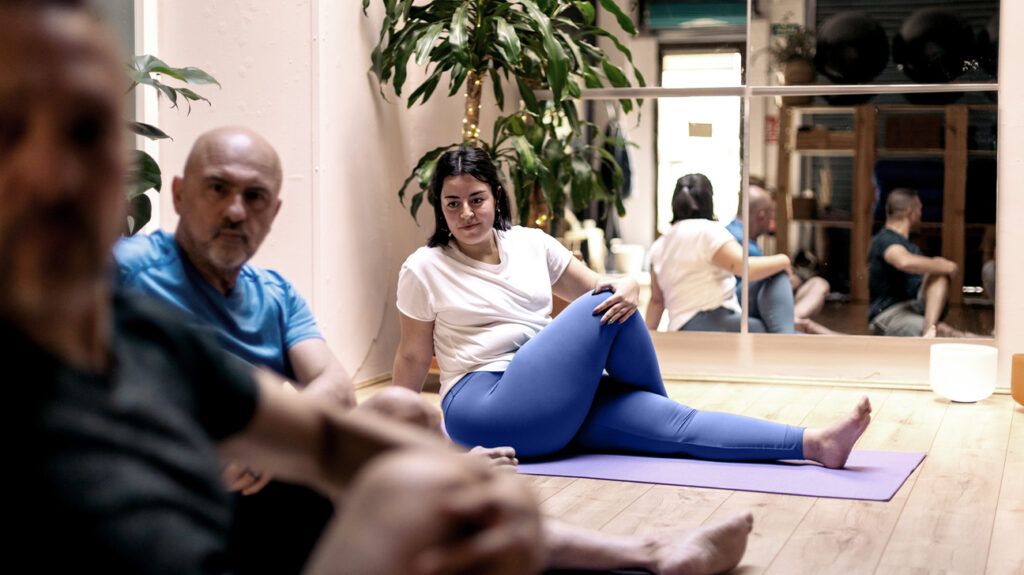
- Yoga is as effective for addressing knee pain due to osteoarthritis as muscle-strengthening exercises, according to a new study.
- The new randomized clinical trial has also found that yoga may improve health-related quality of life and reduce depression in people with knee osteoarthritis.
- Experts say that neither yoga nor strengthening exercises alone are likely to be the most effective way to help treat osteoarthritis knee pain, but can be elements of a broader treatment strategy.
- Adverse effects from both yoga and strengthening exercises reported in the study were minimal.
Knee pain specialists use various therapeutic approaches for helping patients with knee pain due to osteoarthritis. A new study directly compares the effectiveness of two of those therapeutic approaches, yoga and muscle strengthening.
In a randomized clinical trial of 117 participants, yoga’s beneficial effect on knee pain was found to be “noninferior” to that of muscle strengthening after a 12-week study period.
Its findings appear in
The trial, which took place in Tasmania, Australia, involved individuals with a mean age of 62.5 years. Women comprised 72% of the cohort. Participants reported an initial moderate knee pain level of 53.8 according to the 100-point visual analog scale (VAS).
They were divided into two groups, one of which received yoga therapy (58 individuals), and one of which was treated with muscle strengthening (59 people).
The condition of participants’ knees was tracked in multiple ways. These included VAS, as well as the Western Ontario and McMaster Universities Osteoarthritis Index (WOMAC) for knee pain, function, and stiffness. Neuropathic pain and global health assessments were undertaken, as were physical performance measures leg muscle strength tests.
Individuals were also questioned regarding their health-related quality of life and feelings of depression.
Individuals in the yoga group reported modest reductions in depression at 12 weeks compared to those in the muscle-training group, and improvements in quality of life at 24 weeks.
Yoga performed slightly better at 24 weeks for WOMAC pain, function, and stiffness, in the global assessment, and for scores in a fast-paced walking test.
There were no significant adverse effects reported for either yoga or strengthening exercises.
Bert Mandelbaum, MD, not involved in the study, is the co-director of the Regenerative Orthobiologic Center at Cedars-Sinai Orthopaedics in Los Angeles. To him, the study nails down just one detail regarding knee-pain treatment.
Speaking to Medical News Today, Mandelbaum said that, “what we need to know is that [yoga’s] not going to hurt us, but it’s not going to be that robust for us [for treating] arthritis just by itself.”
“Yoga is a good exercise,” he explained, “and it could be utilized in a multiple-mode exercise regiment. Yoga is not going to hurt you. It’s an important part of an overall program that deals with aerobic conditioning, anaerobic conditioning, interval training, flexibility, and yoga, as well as strength training.”
Timothy Gibson, MD, medical director of the MemorialCare Joint Replacement Center at Orange Coast Medical Center in Fountain Valley, CA, also not involved in the study, further pointed out that with yoga being low impact, it “offers the ability to strengthen without aggressive movements in a joint that may be painful to move.”
For older patients especially, Gibson said, yoga can be a great help with balance and fall prevention.
“Yoga can be great for knee osteoarthritis symptoms,” orthopedic surgeon Pamela Mehta, MD, not involved in the study, also told us. “It helps with mobility and stretching, which can greatly impact pain.”
“I’m also not surprised that it had a greater effect on quality of life and mood — yoga is a fantastic mindfulness activity. That said, I don’t find that yoga alone helps my patients in the way this study suggests,” Mehta also cautioned.
Mandelbaum noted that osteoarthritis and its symptoms occur in a continuum along which symptoms tend to progress with time and age. As a result, a patient’s appropriate mix of therapies must be continually re-assessed and adjusted as the condition progresses.
“My view of this is to have something that is a controlled multimodal approach where we evaluate where you are in that continuum. Any prescription should be a combination of aerobic conditioning, and then also consider yoga and exercise training.”
– Bert Mandelbaum, MD
Each element in the response to an individual’s current condition offers a unique benefit to the mix, as is the case of the two modalities compared in the study.
“Yoga,” explained Mehta, “is fantastic for mobility, balance, and flexibility. It helps restore smooth movement in the knee and reduces stiffness, both of which help reduce knee pain from osteoarthritis.”
“Yoga also helps with mindfulness and can improve mental health in a way that exercises don’t. This has a huge impact on how we experience pain,” she added.
Strengthening exercises, as one would expect, work more directly on musculature. They, said Mehta, “are all about support and muscle balance. The muscles that surround the knee joint help the joint move smoothly as you bend, walk, and run.” This can be critical for pain relief.
“Stronger muscles, well-balanced against other leg and hip muscles, help stabilize your knee joint as it moves. This helps to reduce pain in a very functional way, ensuring your knee is moving how it’s supposed to,” Mehta explained.
Gibson pointed out that strength exercises can be handy because they require less instruction and supervision. Moreover, he noted, “having purely more leg strength improves function, especially with ascending and descending stairs.”
Different as they are, the two approaches exemplify how multiple modalities can complement each other, according to Mehta:
“Yoga and strengthening exercises are perfect together, so long as you don’t overdo either one. I always recommend to my patients to practice gentle yoga for mindfulness and mobility while building up their muscle strength with exercises.”
